Teeth implants – the course of treatment
What is an implant?
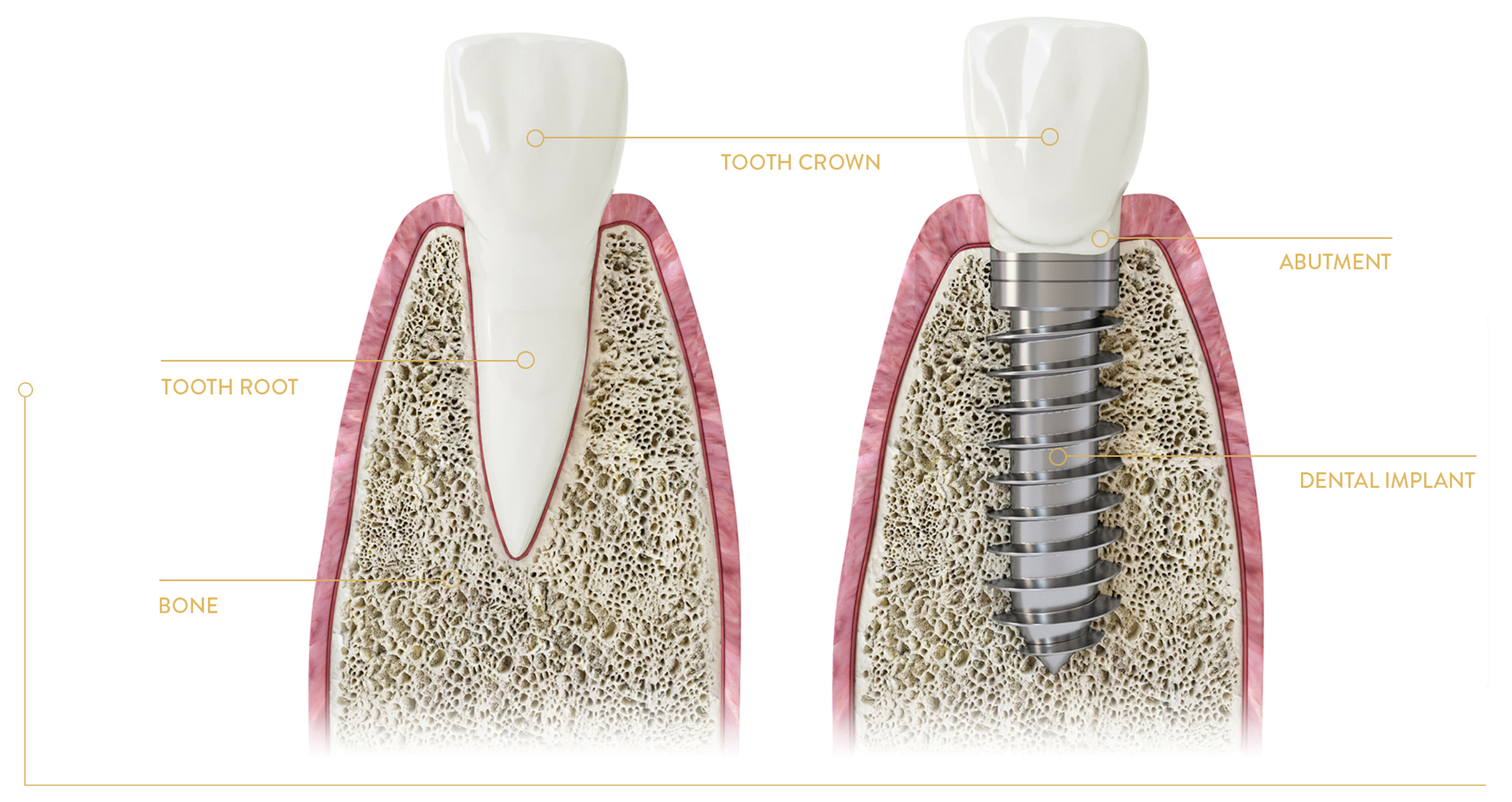
Comparison of natural and artificial teeth
A dental implant, i.e., an intraosseous implant, plays the role of the root of the tooth, and is inserted into the bone of the maxilla or mandibula in place of missing teeth. It is a small and biocompatible titanium screw with a diameter of approx. 3-6 mm and a length of approx. 6-21 mm. The implant acts as a pillar for implant-supported prosthetic restorations – crowns or bridges, as well as a stabiliser for prostheses.
Modern implantology
Implantology is a field of dentistry that has been dynamically developing for over a dozen years. Technological progress has made it possible to restore dental defects using dental implants. The use of intraosseous implants can effectively and permanently improve the quality of life of patients suffering from missing teeth or even complete toothlessness.
Dental implants not only offer the possibility to recreate the natural appearance of teeth, but also successfully restore the functions of missing teeth, such as chewing or articulation. These practical and aesthetic values mean that more and more patients are opting for this treatment.
Implants
Due to the development of implantology, there are a growing number of implant systems on the market. In our clinic, we successfully apply implants, which is one of the most well-known and respected brands in the world. These dental implants are covered by a lifetime warranty.
Indications for the use of implants
Implantology offers a range of solutions to replace:
- a single missing tooth
- several missing teeth
- complete toothlessness
- damaged (compromised) tooth
Dental implants: advantages
- Thanks to the stimulation of bone tissue, dental implants minimise the loss of bone that occurs after the removal of teeth.
- They eliminate the need to file down teeth adjacent to the gap, which is required when using conventional prosthetic bridges. This is especially important when the pillar teeth are completely healthy, because filing involves work on undamaged tissues – enamel – and thus weakens their structure.
- They give the opportunity to restore deficiencies using permanent work. The patient can avoid using an uncomfortable removable prosthesis and thus improve the comfort of daily activities, such as eating or speaking.
- The implant can be used for the rest of the patient’s life, provided proper care and oral hygiene is applied.
Implants – the course of treatment
Treatment planning
In order to plan implant-supported prosthetic treatment, it is necessary to carry out an accurate diagnosis. This is based on general medical history – the patient is asked to complete a detailed health questionnaire – and an intraoral examination. Additional diagnostics are then carried out in the form of radiological examinations, such as:
- an overview photo of the oral cavity – pantomographic (PNX)
- computed tomography (CT)
After collecting data from medical history, physical examination and additional tests, the dentist selects the most appropriate form of treatment for the patient and presents a treatment plan.
INDICATIONS BEFORE IMPLANT SURGERY
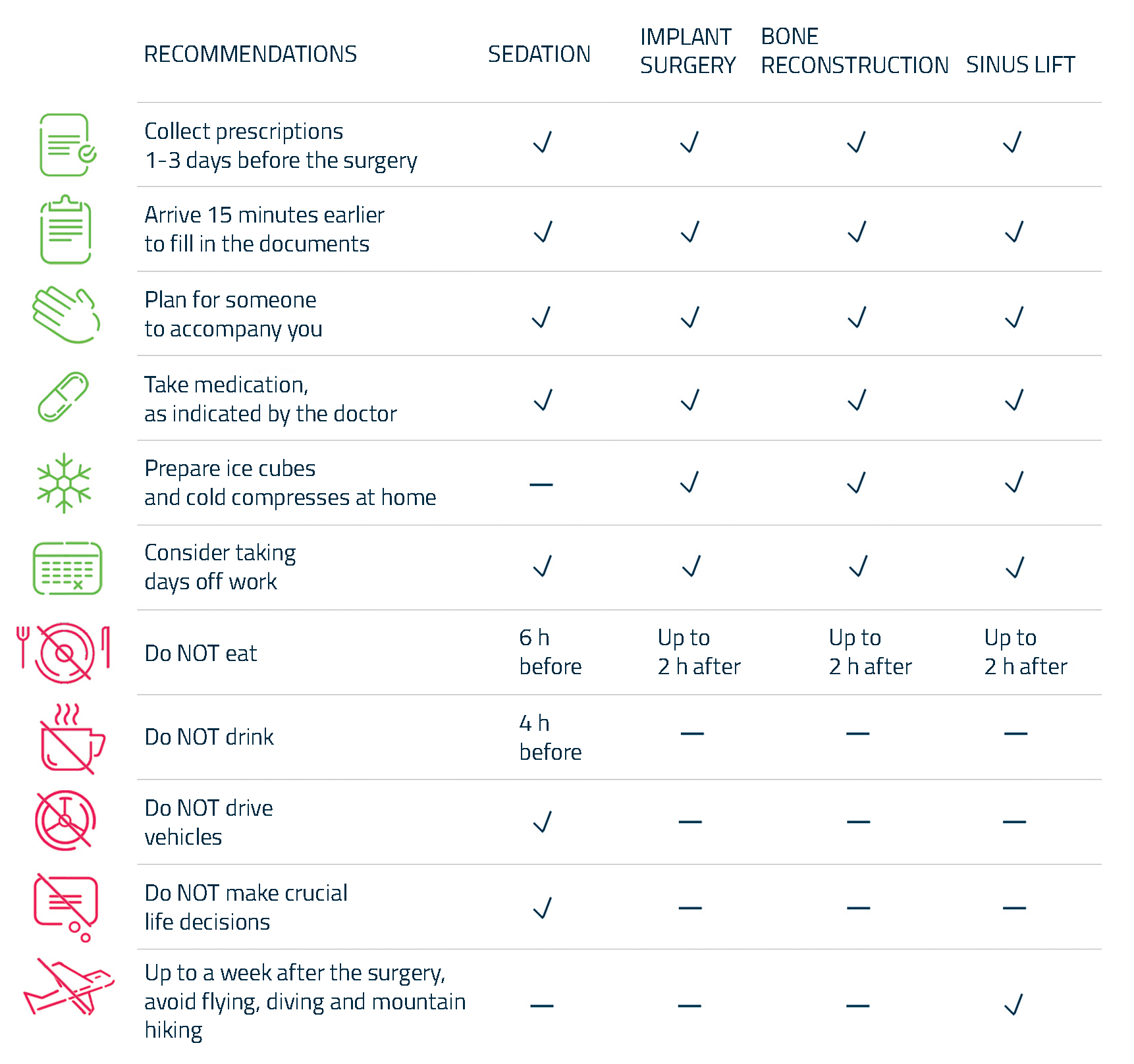
Dental implants – stages of treatment
Implant treatment is a multi-stage process, the length of which depends on the clinical case. Standardly, it follows the following scheme:
- The first stage is placing the implant in the bone. This procedure is carried out under local anaesthesia or in sedation, and is thus painless. The surgery time is on average 30 minutes per implant.
- After about 2 weeks, the stitches, which secured the surgical area, are removed.
- The next stage is healing and connecting the implant with the bone – so-called osseointegration. It lasts 2-3 months in the mandible and 4-6 months in the maxilla. Additional treatments, such as bone regeneration, prolong the time of implant healing.
- After a radiological check to confirm that the implant has correctly integrated, a healing cap is applied – this is an element that shapes the gum around the implant. This procedure is called implant uncovery and is performed under local anaesthesia.
- Approximately 2 weeks after uncovery, you can proceed to the prosthetic stage, where the abutment and prosthetic restoration are prepared. The preparation of final work takes about 2 weeks.
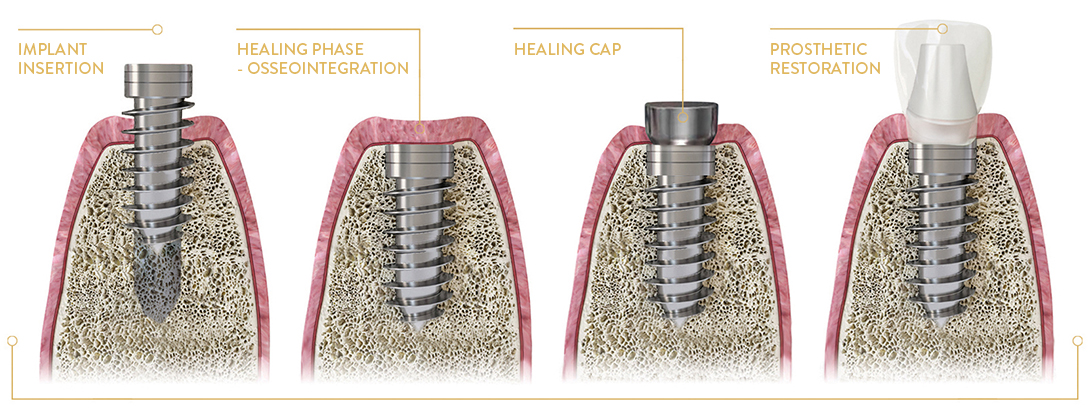
STANDARD PROCESS OF IMPLANT TREATMENT
At each of the stages described above, the absence of the tooth can be masked with temporary work (a provisional tooth), the form of which depends on anatomical conditions. Such work has an aesthetic function and enables the patient to comfortably pass through all stages of treatment until the final reconstruction.
Types of implant treatment
Due to the complexity of implant treatment, the above-described scheme may be modified:
- The main difficulty in treatments using implants is insufficient bone. In such circumstances, additional treatments are required to prepare the patient for treatment – so-called bone regeneration – and thus the duration of treatment may be prolonged. Such situations are known as deferred implant placement, because it is necessary to wait for the bone to heal before inserting the implant.
If anatomical conditions are good, some procedures can be combined, and thus reduce the time of implant treatment, e.g. placing the implant immediately at the moment of tooth extraction (immediate placement) or, if the implant has stabilised well, it can be protected with a healing cap.
Implants – accompanying treatments
Bone reconstruction
After tooth loss, bone atrophy naturally occurs at the extraction site. Depending on the progress of this process, additional procedures may be required when introducing the implant to ensure the safety and long-term success of the treatment.
Bone defects were a serious problem for a long time, as they hindered or prevented treatment involving implants. Along with technological progress and the development of biotechnology, it has become possible to rebuild bones in both the upper and lower jaw. The volume of bone tissue must be increased so that the implants can be inserted and the teeth can be restored. Reconstruction of bone tissue is recommended in the case of:
- bone loss after tooth extraction
- use of removable prosthesis for many years
- post-menopausal osteoporosis and osteoporosis in older age
- genetic determinants
- disorders of calcium-phosphate balance
Before treatment, the level of bone loss should be determined. To this end, radiological diagnostics is carried out – the most common is tomography (CT) – to assess the bone structure in three dimensions. There are three types of atrophy in patients:
- loss of bone height – vertical bone loss
- loss of bone width – horizontal bone loss
- combined loss – mixed bone loss
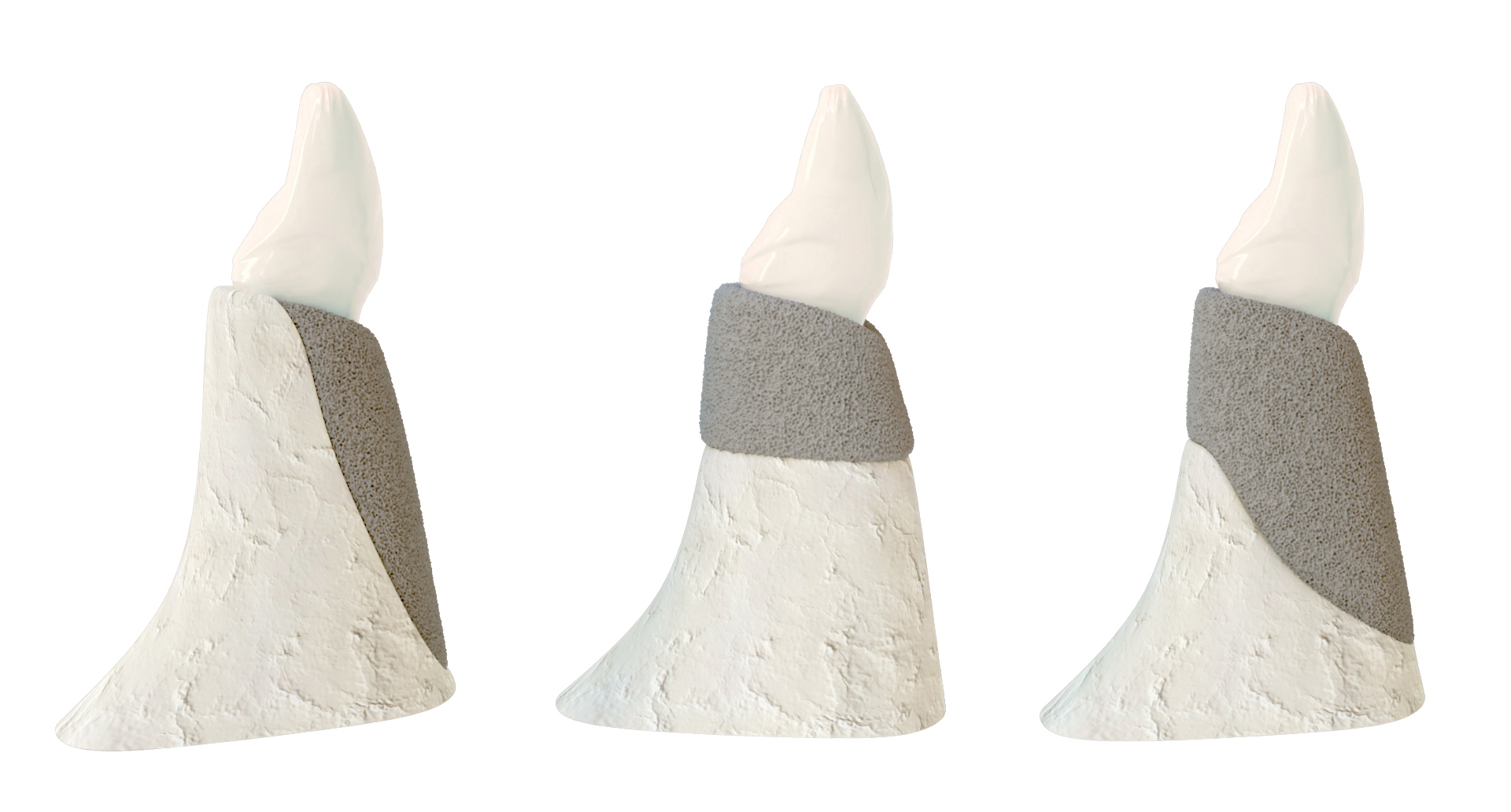
Bone regeneration in relation to the type of bone defect
The type of bone loss diagnosed determines the method and size of regeneration. In general, the bone reconstruction procedure involves increasing the amount of bone tissue by introducing a special bone substitute material where bone is missing, and then securing it with a barrier membrane. This may come from the patient themselves (autogenous bone graft, most often in the form of bone chips) or an external source (special biomaterials of mineral or animal origin). At the Cichoń Dental Centre, we use natural materials derived from either the bone tissue of the patient or from an animal, most often cattle, which are well-absorbed by the human body.
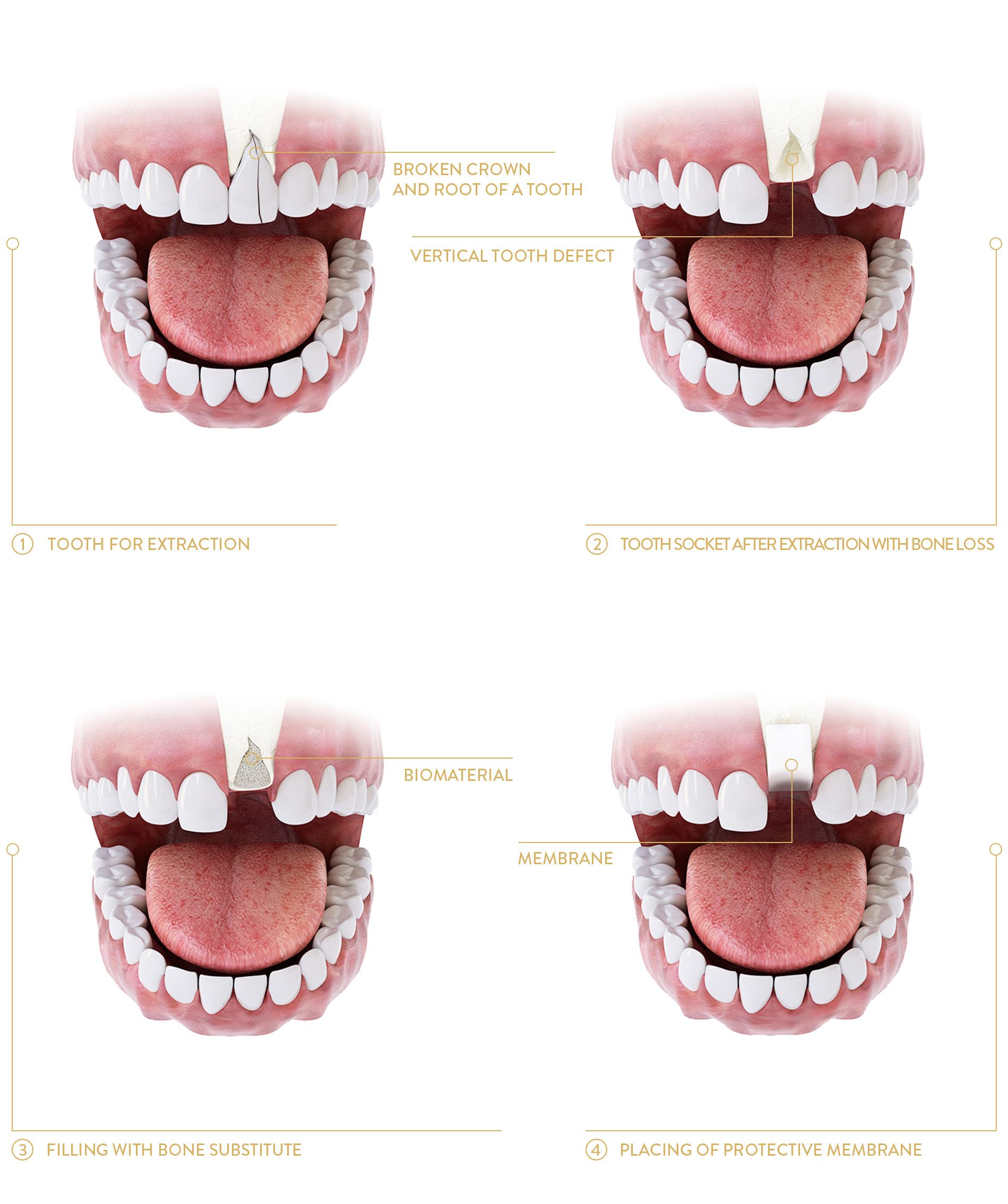

THE PROCESS OF IMPLANT-SUPPORTED PROSTHETIC TREATMENT WITH BONE reCONSTRUCTION
Sinus lift
One special variant of bone regeneration is maxillary sinus floor augmentation, known as Sinus Lift. It is a procedure consisting of the reconstruction of the missing dimension of the alveolar process in the lateral section, where there is a natural space that can be used to create a „new bone”. Thanks to the treatment, the ends of implants that imitate the ends of teeth, do not reach the sinus. Implants thus gain a new, stable foundation. The development of dentistry, including the possibility of performing the Sinus Lift procedure, creates new opportunities for patients who have lost their bone due to prolonged tooth loss and cannot undergo implant treatment due to a „lowered” maxillary sinus.
There are two ways to perform a maxillary sinus lift:
- Maxillary sinus floor augmentation using the open method: the surgeon performs a lateral opening in the alveolar process and introduces the bone substitute material under the mucous membrane of the sinus floor. This method is used when the bone thickness is less than 6 mm. It is used more often, because it offers the possibility of lifting the sinus by about 5-8 mm more than the closed method. It is worth mentioning that this is a more invasive solution.

- Sinus floor augmentation using the closed method: used in the case of a small lift of the sinus (max. 3 mm). The method consists of lifting the mucous membrane and filling the resulting space with bone graft material. During the procedure the sinus floor is not opened, therefore the healing process is faster than in the open method.
The dentist decides whether the patient qualifies for the open or closed procedure based on pantomographic picture and computed tomography.
RECOMMENDATIONS AFTER IMPLANT SURGERY

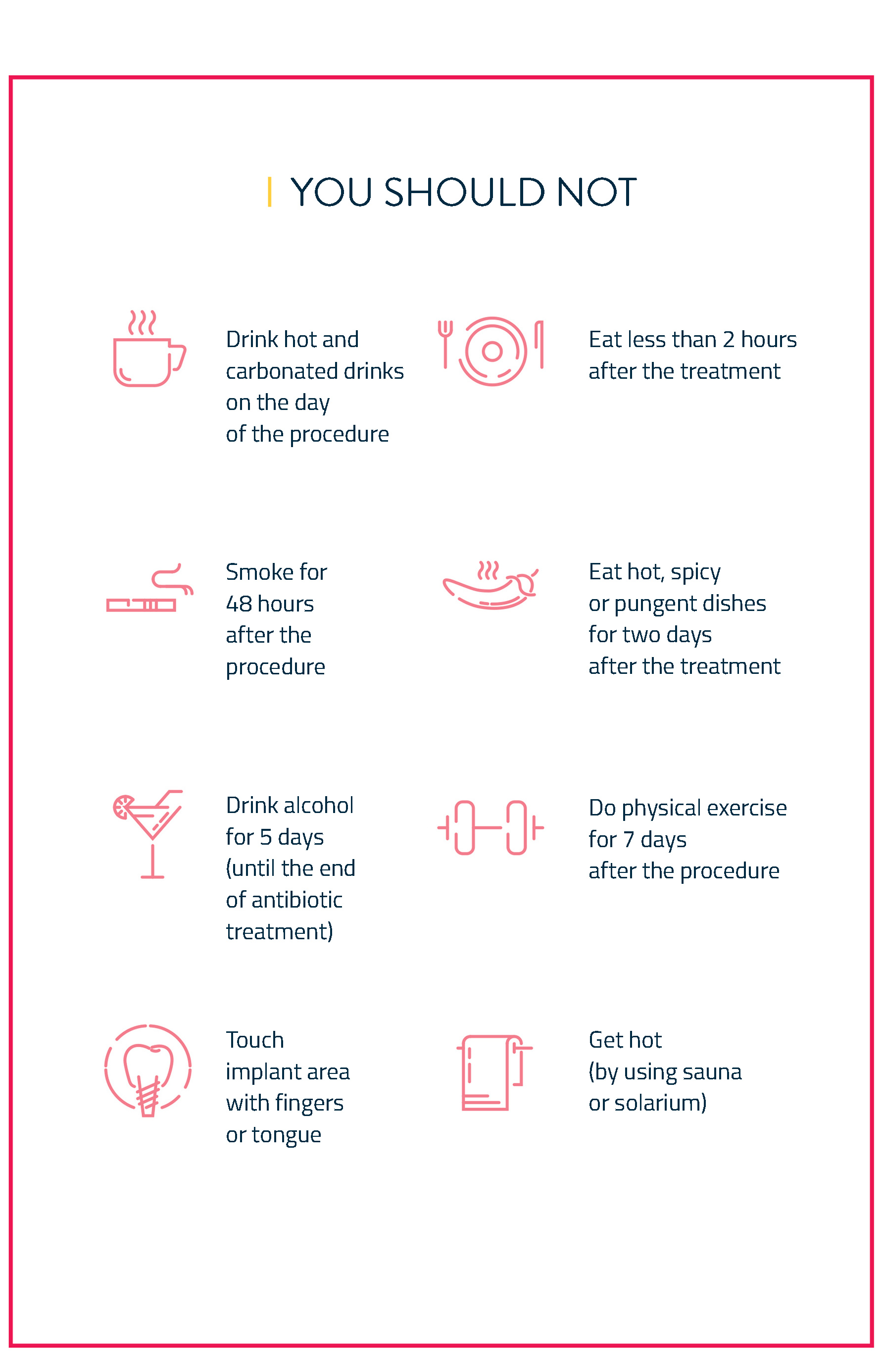
Frequently asked questions
Is fluoride safe?
Fluoride is a toxic element, but only in very large quantities. The doses contained in toothpastes and fluoride varnishes used in accordance with recommendations are completely safe.
Do the deciduous (primary/milk) teeth have nerves?
The deciduous teeth are just as innervated as permanent teeth.
Is it possible to carry out an implant treatment in every patient?
We can carry out implant treatment even in very difficult anatomical cases. However, decisions about the appropriateness of treatment in a given case are always based on a medical history and diagnostic examinations.
In the case of diseases such as diabetes, advanced osteoporosis, diseases of the joints or cardiovascular system, additional consultations are recommended. The main contraindication to implant treatment is the lack of appropriate oral hygiene.
How long is the implant warranty?
Dental implants introduced in our Centre are covered by a lifetime guarantee. However, to maintain the warranty systematic check-ups and regular oral cavity hygiene treatments are necessary.
Why do some people need implants? Is there effective prevention?
Correct oral hygiene and regular dental check-ups help to keep your natural teeth in good condition for as long as possible, thus avoiding the need to replace them with implants. In addition, factors independent of us determine the indications for implant treatment, such as accidents or abnormal growth of the maxilla and mandible.
I have heard that implants are a better solution than a removable prosthesis. Is this true?
Definitely. The implant integrates with the bone and replaces the natural tooth root, providing the patient with maximum comfort. Prostheses that are not based on implants are removable, which affects their stability. In addition, the pressure that accompanies chewing is transferred to the prosthesis and then to the gum, which can cause bone atrophy. For better comfort and to avoid bone atrophy, it is worth opting for implants.
Which implants are the best? How are they different?
Implantology is one of the fastest growing fields of dentistry, and therefore many implant systems are available on the market. At the Cichoń Dental Centre, we implant world-class Nobel Biocare implants. They are made of biocompatible titanium. They differ in thickness, length and shape.
Why are implants considered a better solution in the absence of teeth than a removable prosthesis?
Indeed, implants are a better solution than a prosthesis. All the forces accompanying food chewing are transferred to the crowns of our teeth and then to their roots. The implant is screwed into the bone, with which it integrates perfectly, meaning it replaces the natural root 100%. Dentures are far less comfortable. First of all, the prosthesis is mobile and therefore it will never be as stable as implant work.
Advantages of dental implants:
• provide a strong and stable foundation for artificial teeth that look, feel and function like real teeth
• help to provide attractive and aesthetic smile, as well as keep face shape (they stimulate bone tissue and gums)
• help to maintain the healthy condition of neighbouring teeth by eliminating the use of a clamp and the need to file down adjacent teeth for support under the bridge or prosthesis
Why is it worth choosing implant treatment?
Implants are the best way to replace missing teeth. Implants allow patients to gain a new tooth that allows them to function normally: smile, chew or bite. The implant also fills the gap between healthy teeth, preventing them from moving. In addition, implantological treatment avoids the facial distortion caused by missing teeth.
Is it true that you should fill in a missing tooth as soon as possible?
Yes, it’s true. The place left by the removed tooth is referred to as the “destructive gap”, because at the moment of tooth loss, the distribution of mandibular movement forces along the dental arches gets disturbed. A destructive process begins, which can have irreversible consequences:
– due to the tilting of the teeth in the direction of the gap between the teeth there are breaks – unsightly diastema, which cause inflammation of the gums;
– during the chewing of food, forces that cause the teeth to bend towards the gap are released, which disturbs the symmetry of the smile;
– the bone disappears in the area of the extracted tooth, and the next stage of this process is gum atrophy, which can significantly hinder the performance of aesthetically satisfying prosthetic restoration;
– due to lack of contact with the neighbouring missing tooth, teeth systematically move, which can lead to overloading (dental trauma knot), loosening, and in extreme cases even to the need for further extraction;
– moving of teeth leads to an abnormal occlusion, which may result in changes in the temporomandibular joint.
What is the best way to replace a missing tooth?
One of the best ways to compensate for missing teeth is with an implant-supported prosthesis in the form of crowns or bridges on implants. The advantage of filling missing teeth with implants is, among others, that there is no need to grind the teeth adjacent to the gap. In addition, implant treatment prevents bone atrophy in the absence of a tooth.
Are there any special recommendations that should be followed after bone reconstruction?
The patient should bite the surgical dressing for an hour after the procedure. In case of pain, it is worth taking painkillers, and cold compresses may also be helpful. After the treatment, you should avoid hard or hot meals and reduce physical activity for a few days. For the first three days, please avoid the area of the implant when brushing teeth to prevent irritation.
Is it always possible to rebuild the bone?
Bone regeneration is not always possible. After examining and studying the results of the diagnostic tests, the dentist assesses whether the patient qualifies for surgery.
Is bone reconstruction surgery always connected with implant treatment?
Depending on the severity of the bone atrophy in the patient, bone regeneration can be performed during a separate procedure before the introduction of the implants or during the actual placing of an implant. If bone loss is significant, controlled bone regeneration is performed a few months before implant surgery.
Are biomaterials safe?
The biomaterials used in our clinic are completely safe. Numerous scientific publications prove that such materials are perfectly tolerated by the human body. Their reliability is confirmed by the fact that 3.5 million people have already benefited from them.
Is there effective prevention in the case of Sinus Lift?
People who have had a tooth removed should replace the missing root with a dental implant as soon as possible, thus eliminating the risk of bone loss.
How long after Sinus Lift will the implants be introduced?
Implants are usually placed from 3 to 9 months after the Sinus Lift treatment, because this is how long full bone regeneration lasts. Sometimes, to avoid two operations, if the conditions are right, implants are already introduced during the Sinus Lift procedure.
Is the Sinus Lift surgery under anaesthesia?
Sinus Lift does not require anaesthesia or hospitalisation.
Does every patient planning implant-supported treatment have to undergo the maxillary sinus floor augmentation procedure?
Sinus Lift treatment is necessary for approximately one in five people deciding to introduce an implant. During the visit, the dentist will assess whether the procedure is necessary and whether it can be performed.












